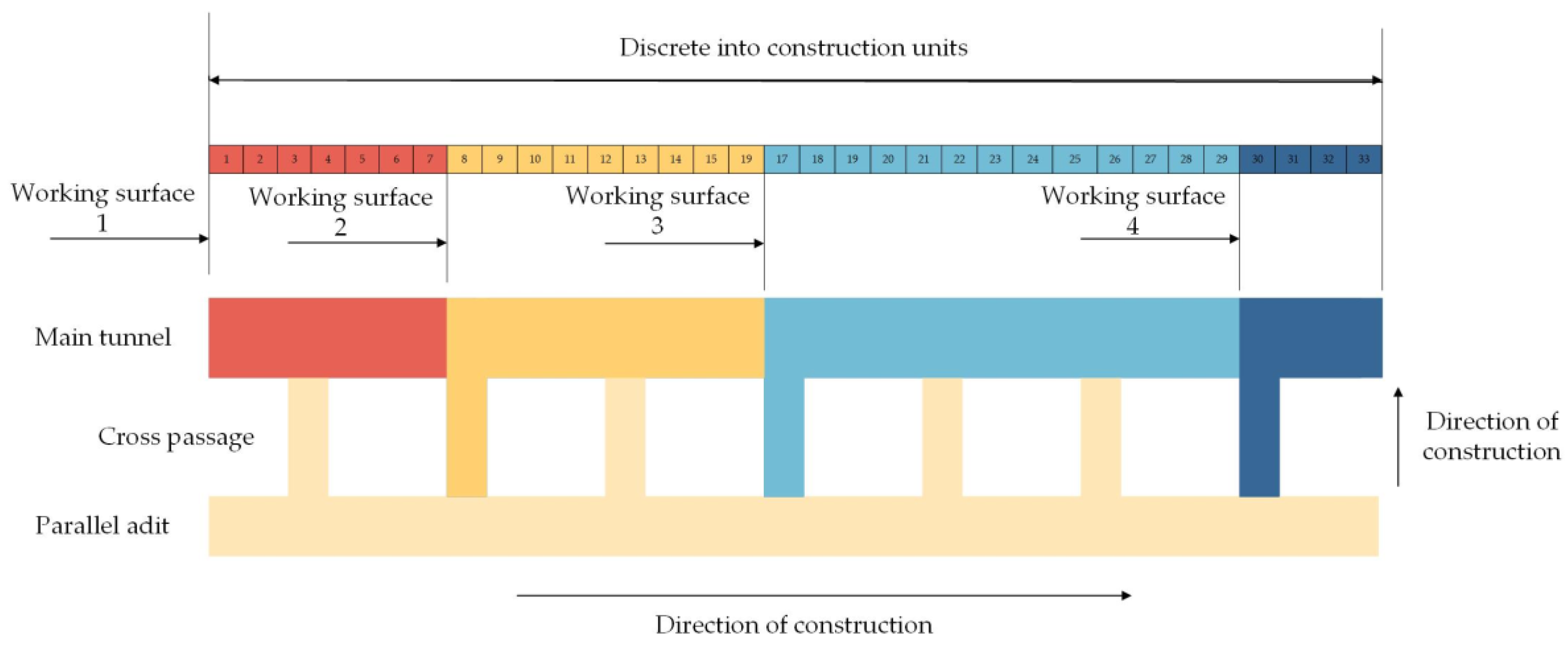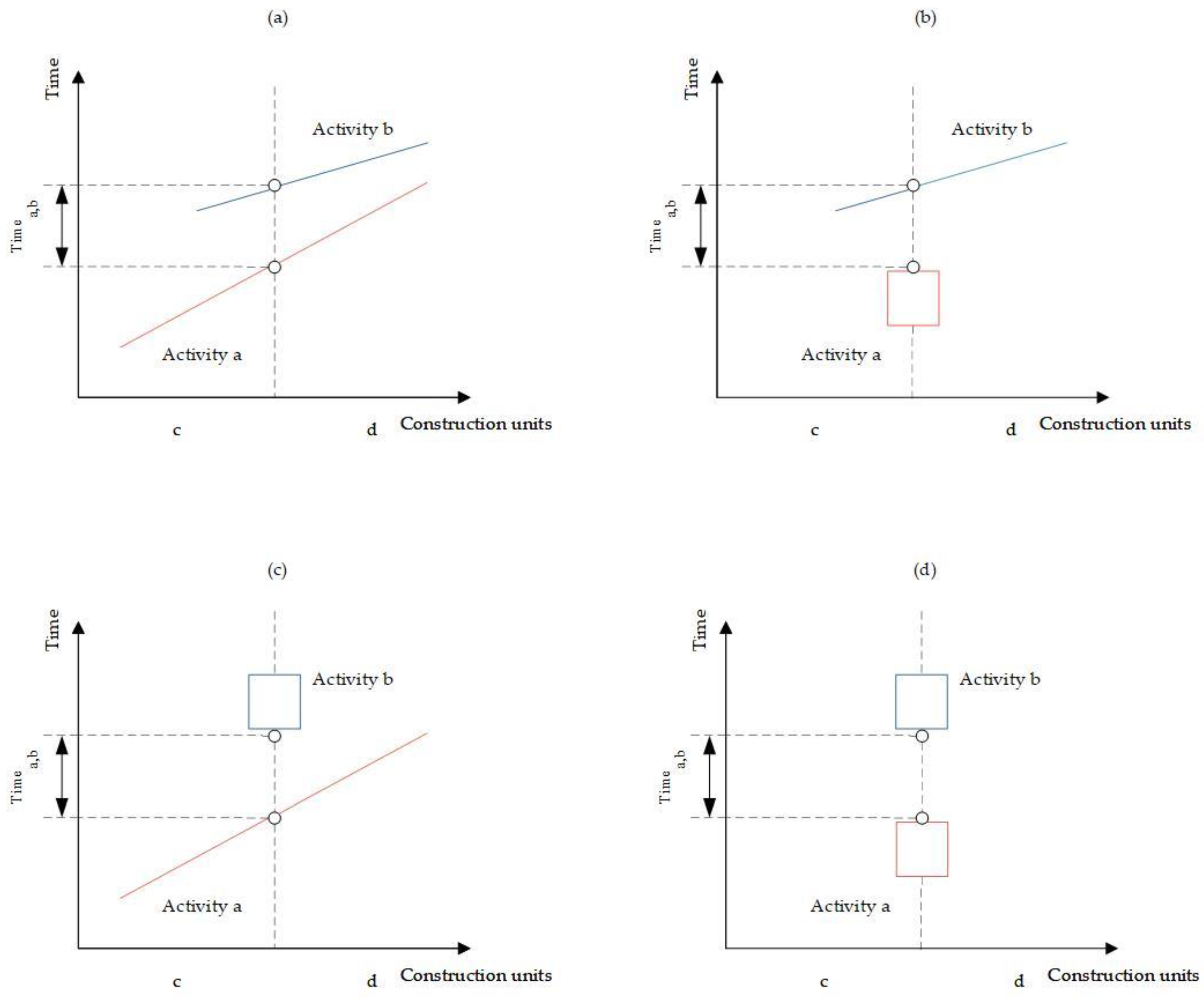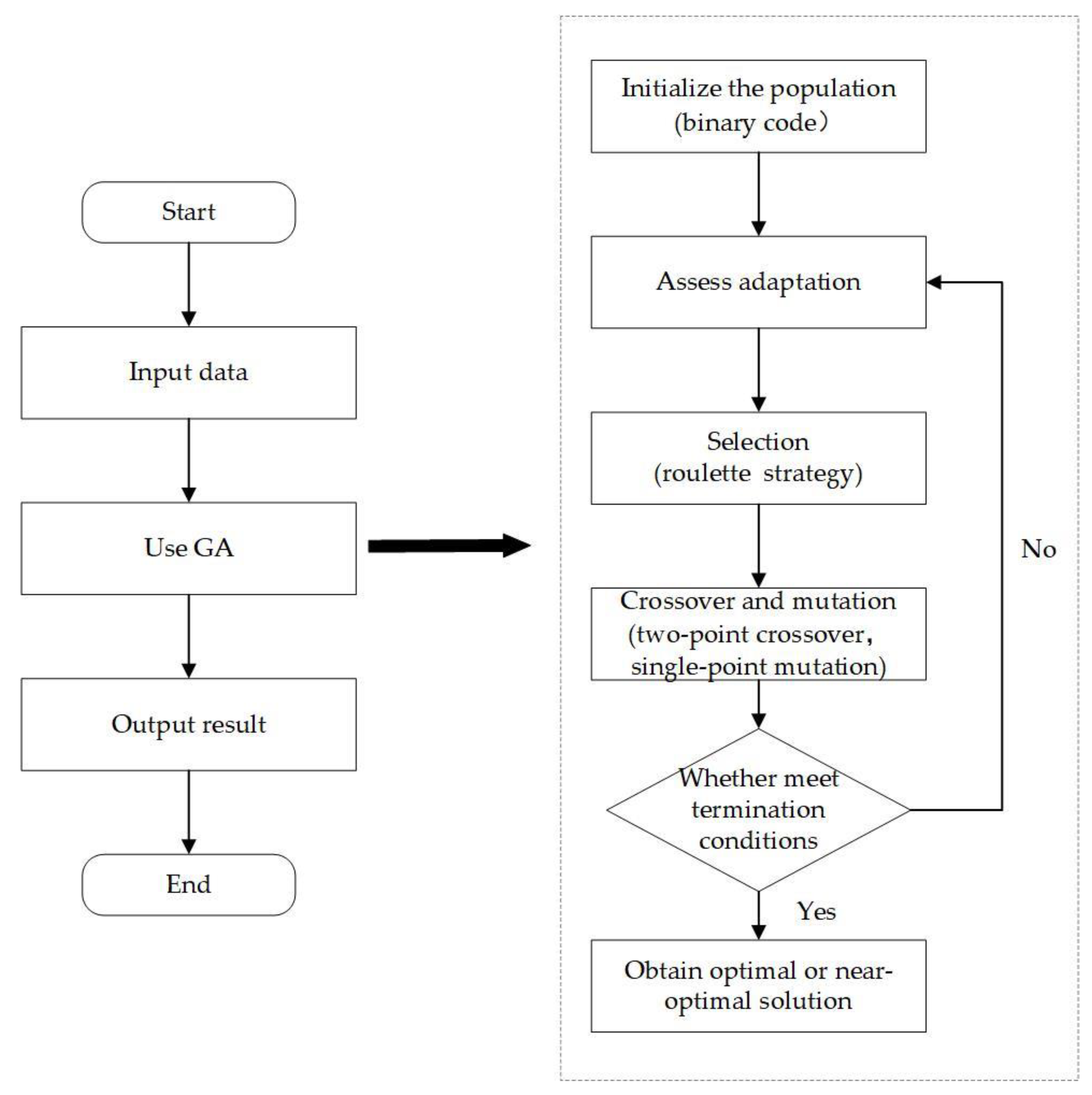Optimization of Tunnel Construction Schedule Considering Soft Logic
Abstract
:1. Introduction
- (1)
- By introducing soft logic relationships into the field of tunnel construction management, this study takes sufficient account of the changes in the construction sequence compared to the traditional fixed sequence in order to optimize the tunnel construction schedule.
- (2)
- A mixed-integer programming (MIP) model for tunnel construction schedule is proposed based on LSM and soft logic relationships, which intuitively represents the constraint relationships related to logic, continuity, time, space, and construction team scheduling.
- (3)
- The optimization issue is addressed using both the exact algorithm and genetic algorithm (GA), followed by a comparative analysis of the outcomes generated by these two methods. The objective is to address the issue being studied to the optimal extent.
2. Literature Review
2.1. Scheduling Optimization for Repetitive Construction Projects
2.2. Scheduling Optimization for Repetitive Construction Projects Based on LSM
2.3. Scheduling Optimization for Repetitive Construction Projects Based on Soft Logic
2.4. Knowledge Gaps
3. Method
3.1. Problem Description
3.2. Mathematical Model
3.2.1. Parameters
3.2.2. Objective Function
3.2.3. Constraints
- (1)
- Logical constraints
- S-S relationship
- 2.
- F-S relationship
- 3.
- S-F relationship
- 4.
- F-F relationship
- (2)
- Work continuity constraints
- (3)
- Temporal constraints
- The relationships when both activities a and b are linear, or when one of them is linear, are shown in Equations (14) and (15).
- 2.
- When both activities a and b are strip or block activities, the relationships are shown in Equations (16) and (17).
- (4)
- Spatial constraints
- (5)
- Construction team constraints
4. Algorithm Design and Model Verification
4.1. Exact Algorithm
- (1)
- The optimization of the model with linear constraints leads to an initial solution.
- (2)
- Add the cutting plane constraint for working surface switching and continue the solution. When the initial construction team completes a job task and moves on to work on an additional working surface, the start time of the new working surface must be greater than or equal to the completion time of the previous working surface.
- (3)
- Repeat the above steps until an optimal solution is found.
4.2. Genetic Algorithm
4.2.1. Initialize the Population
4.2.2. Fitness Function
4.2.3. Selection
4.2.4. Crossover and Mutation
4.3. Model Verification
5. Practical Case Study
5.1. Case Description
5.2. Results and Analysis
6. Conclusions
- (1)
- In tunnel construction management, combining soft logic relationships with LSM allows for scenarios where the construction sequence can be changed. In this situation, with work continuity and other conditions as constraints, the duration can be optimized by the creation of additional working surfaces. This could offer a new means of optimizing the tunnel construction schedule.
- (2)
- An MIP model that is applicable to tunnel construction is constructed, which intuitively represents the linear and nonlinear relationships between various construction activities. This provides a reference for the application of the mathematical planning in the optimization of tunnel construction schedules.
- (3)
- Both the exact algorithm and GA are utilized to solve the above-mentioned MIP model using Python 3.7.0, and the obtained results are subsequently analyzed. With the same degree of accuracy, optimization results can be obtained more quickly via GA, which sufficiently demonstrates the superiority of using GA for the optimization of tunnel construction schedules.
- (4)
- The paper carries on the analysis of the actual construction project case, and puts forward improvement strategies with significant practical value. Through the implementation of the TSMOM model and related algorithms, managers can not only optimize resource utilization and enhance construction efficiency, but they also reduce the risk of delays while meeting project requirements. This is conducive to the development of tunnel construction management.
Author Contributions
Funding
Institutional Review Board Statement
Informed Consent Statement
Data Availability Statement
Conflicts of Interest
Appendix A
| Distance (Meter) | Construction Speed (Meter/Month) | Duration (Day) |
|---|---|---|
| 0 | — | — |
| 94 | 70 | 37 |
| 294 | 130 | 46 |
| 379 | 70 | 36 |
| 1124 | 130 | 172 |
| 1371 | 70 | 106 |
| 1471 | 30 | 100 |
| 1509 | 70 | 17 |
| 1689 | 130 | 42 |
| 1964 | 190 | 44 |
| 2124 | 130 | 37 |
| 2354 | 190 | 36 |
| 3004 | 130 | 150 |
| 3064 | 30 | 60 |
| 3244 | 70 | 78 |
| 3434 | 130 | 44 |
| 3524 | 65 | 42 |
| 3654 | 30 | 130 |
| 3714 | 70 | 26 |
| 4704 | 130 | 229 |
| 5169 | 70 | 199 |
| 5969 | 130 | 185 |
| 6069 | 70 | 43 |
| 6169 | 30 | 100 |
| 6284 | 70 | 49 |
| 6949 | 130 | 184 |
| 7079 | 30 | 130 |
References
- Zou, X.; Zhang, L.; Zhang, Q. Time-Cost Optimization in Repetitive Project Scheduling with Limited Resources. Eng. Constr. Archit. Manag. 2022, 29, 669–701. [Google Scholar] [CrossRef]
- Monghasemi, S.; Abdallah, M. Linear Optimization Model to Minimize Total Cost of Repetitive Construction Projects and Identify Order of Units. J. Manag. Eng. 2021, 37, 04021036. [Google Scholar] [CrossRef]
- Ding, H.; Zhuang, C.; Liu, J. Extensions of the Resource-Constrained Project Scheduling Problem. Autom. Constr. 2023, 153, 104958. [Google Scholar] [CrossRef]
- Kamandanipour, K.; Tavakkoli-Moghaddam, R.; Haji Yakhchali, S. A Discrete Time/Resource Trade-off Problem with a Critical Chain Method under Uncertainty: A Hybrid Meta-Heuristic Algorithm. Soft Comput. 2023, 27, 17867–17885. [Google Scholar] [CrossRef]
- Altuwaim, A.; El-Rayes, K. Multiobjective Optimization Model for Planning Repetitive Construction Projects. J. Constr. Eng. Manag. 2021, 147, 04021072. [Google Scholar] [CrossRef]
- Tomczak, M.; Jaśkowski, P. Harmonizing Construction Processes in Repetitive Construction Projects with Multiple Buildings. Autom. Constr. 2022, 139, 104266. [Google Scholar] [CrossRef]
- Hegazy, T.; Mostafa, K.; Ojulari, S. Tetris-Inspired Approach for Generating Tightly-Packed Repetitive Schedules. Autom. Constr. 2021, 124, 103601. [Google Scholar] [CrossRef]
- Yogesh, G.; Hanumanth Rao, C. A Study on Linear Scheduling Methods in Road Construction Projects. Mater. Today Proc. 2021, 47, 5475–5478. [Google Scholar] [CrossRef]
- Tang, Y.; Liu, R.; Wang, F.; Sun, Q.; Kandil, A.A. Scheduling Optimization of Linear Schedule with Constraint Programming. Comput. Aided Civ. Infrastruct. Eng. 2018, 33, 124–151. [Google Scholar] [CrossRef]
- Wang, Z.; Hu, Z.; Tang, Y. Float-Based Resource Leveling Optimization of Linear Projects. IEEE Access 2020, 8, 176997–177020. [Google Scholar] [CrossRef]
- Eid, M.S.; Elbeltagi, E.E.; El-Adaway, I.H. Simultaneous Multi-Criteria Optimization for Scheduling Linear Infrastructure Projects. Int. J. Constr. Manag. 2021, 21, 41–55. [Google Scholar] [CrossRef]
- García-Nieves, J.D.; Ponz-Tienda, J.L.; Ospina-Alvarado, A.; Bonilla-Palacios, M. Multipurpose Linear Programming Optimization Model for Repetitive Activities Scheduling in Construction Projects. Autom. Constr. 2019, 105, 102799. [Google Scholar] [CrossRef]
- Liu, S.-S.; Budiwirawan, A.; Arifin, M.F.A. Non-Sequential Linear Construction Project Scheduling Model for Minimizing Idle Equipment Using Constraint Programming (CP). Mathematics 2021, 9, 2492. [Google Scholar] [CrossRef]
- Hegazy, T.; Kamarah, E. Schedule Optimization for Scattered Repetitive Projects. Autom. Constr. 2022, 133, 104042. [Google Scholar] [CrossRef]
- Zou, X.; Wu, G.; Zhang, Q. Work Continuity Constraints in Repetitive Project Scheduling Considering Soft Logic. Eng. Constr. Archit. Manag. 2021, 28, 1713–1738. [Google Scholar] [CrossRef]
- Hegazy, T.; Saad, D.A.; Mostafa, K. Enhanced Repetitive-Scheduling Computation and Visualization. J. Constr. Eng. Manag. 2020, 146, 04020118. [Google Scholar] [CrossRef]
- Hu, Z.; Wang, F.; Tang, Y. Scenario-oriented Repetitive Project Scheduling Optimization. Comput. Aided Civ. Infrastruct. Eng. 2023, 38, 1239–1273. [Google Scholar] [CrossRef]
- Salama, T.; Moselhi, O. Multi-Objective Optimization for Repetitive Scheduling under Uncertainty. Eng. Constr. Archit. Manag. 2019, 26, 1294–1320. [Google Scholar] [CrossRef]
- Altuwaim, A.; El-Rayes, K. Minimizing Duration and Crew Work Interruptions of Repetitive Construction Projects. Autom. Constr. 2018, 88, 59–72. [Google Scholar] [CrossRef]
- Hassan, A.; El-Rayes, K.; Attalla, M. Optimizing the Scheduling of Crew Deployments in Repetitive Construction Projects under Uncertainty. Eng. Constr. Archit. Manag. 2021, 28, 1615–1634. [Google Scholar] [CrossRef]
- Altuwaim, A.; El-Rayes, K. Optimizing the Scheduling of Repetitive Construction to Minimize Interruption Cost. J. Constr. Eng. Manag. 2018, 144, 04018051. [Google Scholar] [CrossRef]
- Shafahi, A.; Haghani, A. Project Selection and Scheduling for Phase-Able Projects with Interdependencies among Phases. Autom. Constr. 2018, 93, 47–62. [Google Scholar] [CrossRef]
- Zhentao, H.; Nanfang, C.; Xuejun, H.; Edgar Mahaffey, M.A. Time- and Resource-Based Robust Scheduling Algorithms for Multi-Skilled Projects. Autom. Constr. 2023, 153, 104948. [Google Scholar] [CrossRef]
- Tang, Y.; Liu, R.; Sun, Q. Two-Stage Scheduling Model for Resource Leveling of Linear Projects. J. Constr. Eng. Manag. 2014, 140, 04014022. [Google Scholar] [CrossRef]
- Tran, D.-H.; Chou, J.-S.; Luong, D.-L. Optimizing Non-Unit Repetitive Project Resource and Scheduling by Evolutionary Algorithms. Oper. Res. Int. J. 2022, 22, 77–103. [Google Scholar] [CrossRef]
- Yu, Z.; Wang, C.; Zhao, Y.; Hu, Z.; Tang, Y. Linear Project-Scheduling Optimization Considering a Reverse Construction Scenario. Appl. Sci. 2023, 13, 9407. [Google Scholar] [CrossRef]
- Gupta, R.; Trivedi, M.K. AEHO: Apriori-Based Optimized Model for Building Construction to Time-Cost Tradeoff Modeling. IEEE Access 2022, 10, 103852–103871. [Google Scholar] [CrossRef]
- Huang, Y.; Zou, X.; Zhang, L. Genetic Algorithm–Based Method for the Deadline Problem in Repetitive Construction Projects Considering Soft Logic. J. Manag. Eng. 2016, 32, 04016002. [Google Scholar] [CrossRef]
- Tao, S.; Wu, C.; Sheng, Z.; Wang, X. Space-Time Repetitive Project Scheduling Considering Location and Congestion. J. Comput. Civ. Eng. 2018, 32, 04018017. [Google Scholar] [CrossRef]
- Su, Y.; Lucko, G. Linear Scheduling with Multiple Crews Based on Line-of-Balance and Productivity Scheduling Method with Singularity Functions. Autom. Constr. 2016, 70, 38–50. [Google Scholar] [CrossRef]
- Hegazy, T.; Abdel-Monem, M.; Atef Saad, D. Framework for Enhanced Progress Tracking and Control of Linear Projects. Eng. Constr. Archit. Manag. 2014, 21, 94–110. [Google Scholar] [CrossRef]
- Tang, Y.; Liu, R.; Sun, Q. Schedule Control Model for Linear Projects Based on Linear Scheduling Method and Constraint Programming. Autom. Constr. 2014, 37, 22–37. [Google Scholar] [CrossRef]
- Tang, Y.; Sun, Q.; Liu, R.; Wang, F. Resource Leveling Based on Line of Balance and Constraint Programming. Comput. Aided Civ. Infrastruct. Eng. 2018, 33, 864–884. [Google Scholar] [CrossRef]
- Yamín, R.A.; Harmelink, D.J. Comparison of Linear Scheduling Model (LSM) and Critical Path Method (CPM). J. Constr. Eng. Manag. 2001, 127, 374–381. [Google Scholar] [CrossRef]
- García-Nieves, J.D.; Ponz-Tienda, J.L.; Salcedo-Bernal, A.; Pellicer, E. The Multimode Resource-Constrained Project Scheduling Problem for Repetitive Activities in Construction Projects. Comput. Aided Civ. Infrastruct. Eng. 2018, 33, 655–671. [Google Scholar] [CrossRef]
- Lucko, G.; Alves, T.D.C.L.; Angelim, V.L. Challenges and Opportunities for Productivity Improvement Studies in Linear, Repetitive, and Location-Based Scheduling. Constr. Manag. Econ. 2014, 32, 575–594. [Google Scholar] [CrossRef]
- Tamimi, S.; Diekmann, J. Soft Logic in Network Analysis. J. Comput. Civ. Eng. 1988, 2, 289–300. [Google Scholar] [CrossRef]
- Fan, S.-L.; Tserng, H.P.; Wang, M.-T. Development of an Object-Oriented Scheduling Model for Construction Projects. Autom. Constr. 2003, 12, 283–302. [Google Scholar] [CrossRef]
- Zou, X.; Zhang, L. A Constraint Programming Approach for Scheduling Repetitive Projects with Atypical Activities Considering Soft Logic. Autom. Constr. 2020, 109, 102990. [Google Scholar] [CrossRef]
- Pan, X.; Zhao, X.; Shen, H. The Concept, Influence, and Mechanism of Human Work Interruptions Based on the Grounded Theory. Front. Psychol. 2023, 14, 1044233. [Google Scholar] [CrossRef]
- Peiris, A.; Hui, F.K.P.; Duffield, C.; Ngo, T. Production Scheduling in Modular Construction: Metaheuristics and Future Directions. Autom. Constr. 2023, 150, 104851. [Google Scholar] [CrossRef]







| Index | |
|---|---|
| Set of activities, i ∈N | |
| Set of construction units, , represents the construction unit where the activity starts and ends, j ∈M | |
| Optional additional working surface points, s | |
| Variables |
|---|
| Indicator variable |
| Constant | |
|---|---|
| Q | Work quantity |
| Expected project completion time | |
| W | Number of construction teams |
| Distance constraints between the original working surface and the additional working surface | |
| Distance of optional additional working surface point from the starting point, r | |
| Duration of working surface | |
| The start time of the working surface opened from unit | |
| The end time of the working surface opened from unit | |
| The duration of the working surface opened from unit j | |
| Start time of activity i in each unit | |
| End time of activity i in each unit , | |
| Duration of activity i in each unit , | |
| Speed of activity i in unit | |
| Minimum interval between activities and | |
| Maximum interval between activities and | |
| Minimum separation distance between activities and | |
| Maximum separation distance between activities and | |
| A | A sufficiently large positive number |
| Name | Average Construction Speed (Meter/Day) |
|---|---|
| Main tunnel | 2.3 |
| Parallel adit | 4.3 |
| Cross passage | 4.3 |
| Distance Constraint (Meter) | Selection Point for Additional Working Surface | Total Duration (Day) |
|---|---|---|
| 1000 | 7, 13 | 1958 |
| 800 | 5, 10, 14 | 1872 |
| 6, 10, 14 | 1872 | |
| 600 | 5, 8, 11, 14 | 1826 |
| Name | Tunnel Rock Mass Rating | Average Construction Speed (Meter/Month) |
|---|---|---|
| Main tunnel | III | 180 |
| IV | 90 | |
| V | 50 | |
| Parallel adit | III | 190 |
| IV | 130 | |
| V | 70 | |
| Cross passage | - | 33.3 |
| Name | Selection Point for Additional Working Surface | Total Duration (Day) | Idle Time for Construction Team (Day) | Total Working Time of the Construction Team (Day) |
|---|---|---|---|---|
| Optimization Program 1 | 6, 11, 13, 15 | 2387 | Team 1: 741 | Team 1: 1646 |
| Team 2: 0 | Team 2: 1687 | |||
| Total: 741 | Team 3: 2287 | |||
| Optimization Program 2 | 7, 11, 13, 15 | 2387 | Team 1: 597 | Team 1: 1790 |
| Team 2: 0 | Team 2: 1543 | |||
| Total: 597 | Team 3: 2287 | |||
| Optimization Program 3 | 8, 12, 15 | 2387 | Team 1: 343 | Team 1: 1996 |
| Team 2: 159 | Team 2: 1262 | |||
| Total: 502 | Team 3: 2287 | |||
| Optimization Program 4 | 8, 13, 15 | 2387 | Team 1: 459 | Team 1: 1829 |
| Team 2: 0 | Team 2: 1428 | |||
| Total: 459 | Team 3: 2287 |
Disclaimer/Publisher’s Note: The statements, opinions and data contained in all publications are solely those of the individual author(s) and contributor(s) and not of MDPI and/or the editor(s). MDPI and/or the editor(s) disclaim responsibility for any injury to people or property resulting from any ideas, methods, instructions or products referred to in the content. |
© 2024 by the authors. Licensee MDPI, Basel, Switzerland. This article is an open access article distributed under the terms and conditions of the Creative Commons Attribution (CC BY) license (https://creativecommons.org/licenses/by/4.0/).
Share and Cite
Wei, J.; Liu, Y.; Lu, X.; Feng, Y.; Wang, Y. Optimization of Tunnel Construction Schedule Considering Soft Logic. Appl. Sci. 2024, 14, 2580. https://doi.org/10.3390/app14062580
Wei J, Liu Y, Lu X, Feng Y, Wang Y. Optimization of Tunnel Construction Schedule Considering Soft Logic. Applied Sciences. 2024; 14(6):2580. https://doi.org/10.3390/app14062580
Chicago/Turabian StyleWei, Jianying, Yuming Liu, Xiaochun Lu, Yu Feng, and Yadi Wang. 2024. "Optimization of Tunnel Construction Schedule Considering Soft Logic" Applied Sciences 14, no. 6: 2580. https://doi.org/10.3390/app14062580
APA StyleWei, J., Liu, Y., Lu, X., Feng, Y., & Wang, Y. (2024). Optimization of Tunnel Construction Schedule Considering Soft Logic. Applied Sciences, 14(6), 2580. https://doi.org/10.3390/app14062580







